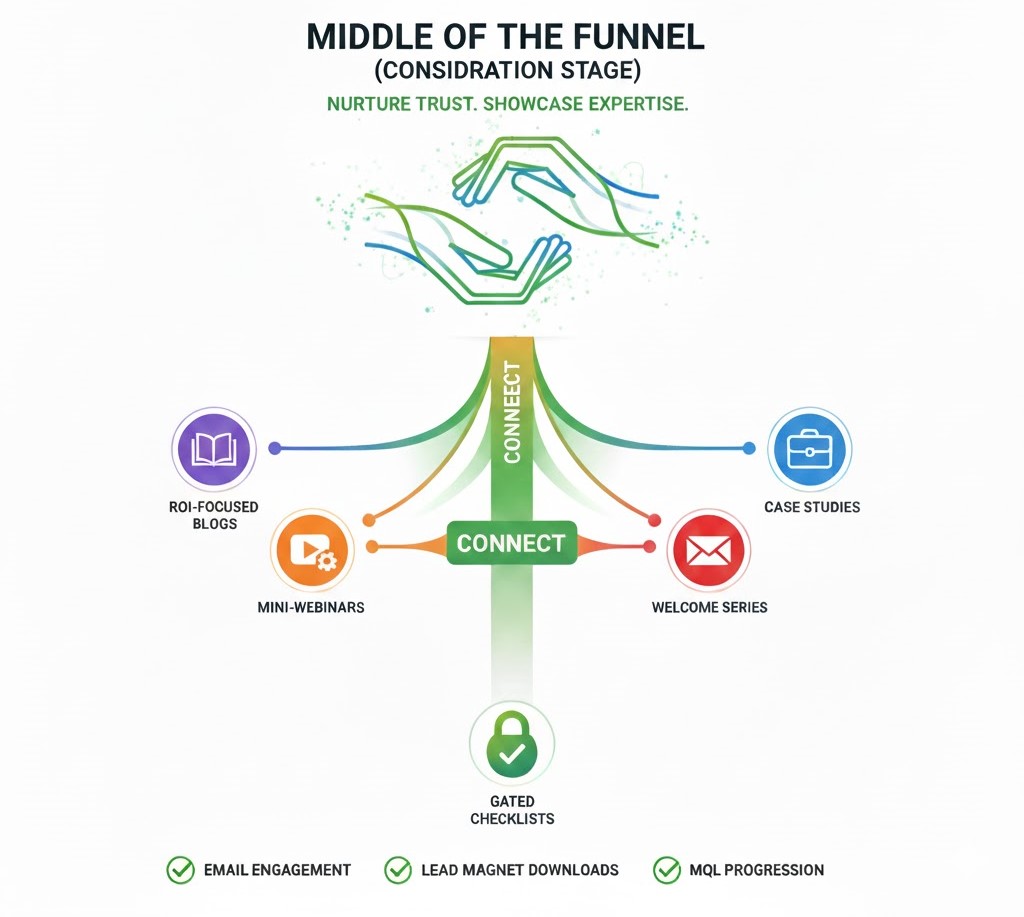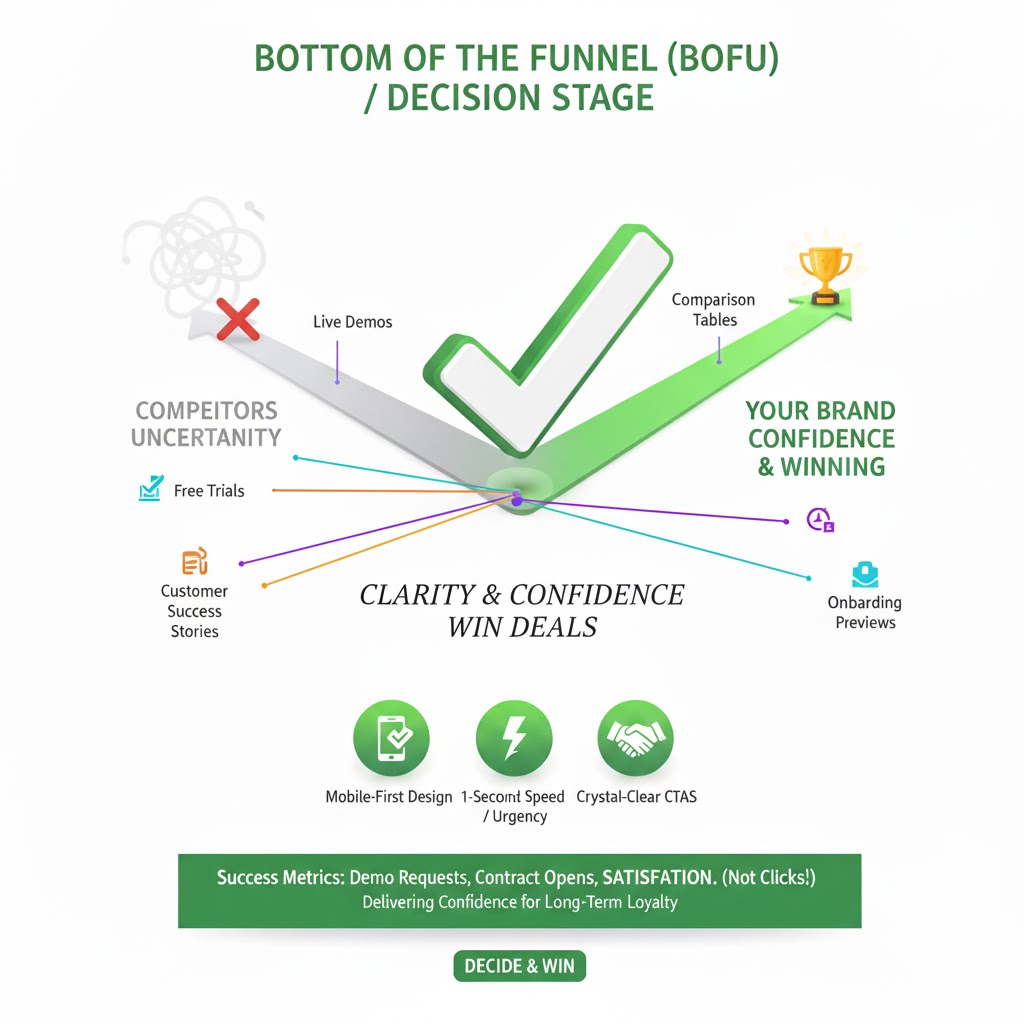Marketing Funnel Explained: Master TOFU, MOFU, BOFU for Effective Lead Nurturing
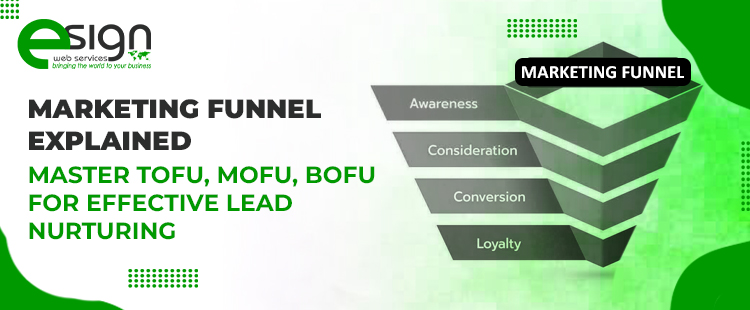
Key Takeaways
- Marketing Funnel Optimization structures TOFU, MOFU, BOFU to guide buyers from awareness to purchase effectively.
- TOFU publishes problem led content across search and social; measure reach, CTR, engaged sessions weekly.
- MOFU teaches specifics using calculators, webinars, and case studies; segment audiences with Marketing Automation intelligently.
- BOFU builds proof hubs: clear pricing, short forms, testimonials, demos, trials; removing purchase friction decisively.
- Funnel Analytics using GA4, CRM, and dashboards exposes drop-offs, lags, prioritizing highest-impact fixes each week.
- Customer Engagement Strategies deploy polls, Q and A sessions, minicourses converting attention into intent reliably.
- Funnel Content Strategy maps objections to assets with single CTA; retarget using education, not discounts.
- Post purchase onboarding, success check-ins, referrals, and user content compound lifetime value significantly over time.
Hooked on impressions but starving for sales? That’s not a reach problem; it’s Marketing Funnel Optimization. Modern buyers zig-zag across search, social, reviews, and inboxes; most need 6–8+ touchpoints before they trust a brand enough to act. They compare, question, and research before trusting and your funnel needs to meet them at every step with relevance and reassurance. The fix is structure. At the Top of Funnel (TOFU), publish problem-solving content that answers the first questions and earns attention. In the Middle of Funnel (MOFU), deepen proof with mini case studies, comparison explainers, and helpful emails that remove doubt.
At Bottom of Funnel (BOFU), cut friction: fast pages, clear pricing, concise demos, and social proof near the CTA. A disciplined Funnel Marketing Strategy uses Marketing Automation to time messages to behavior (not guesswork) and Funnel Analytics to spot leaks by stage; bounce, drop-offs, and conversion lag. Do this well, and Customer Engagement Strategies stop being theory: attention compounds, skepticism fades, and clicks mature into booked calls, trials, and paid accounts. That’s the power of Marketing Funnel Optimization done right.
Digital Marketing Funnel
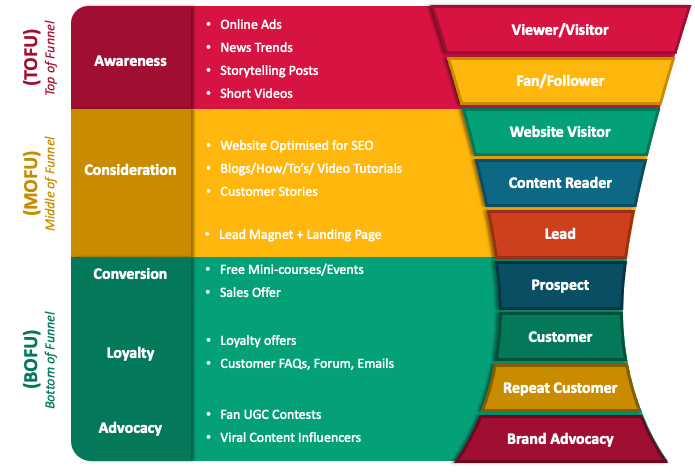
TOFU – Top of the Funnel (Awareness Stage)
At the Top of the Funnel (TOFU) stage, your audience doesn’t know your brand — yet. The mission isn’t to sell but to spark curiosity and earn attention through helpful, value-driven content. A strong Funnel Content Strategy focuses on answering early-stage questions and showing up consistently where your ideal buyers spend time. For B2B audiences, that means optimizing for Google Search, sharing thought leadership on LinkedIn, and creating educational videos on YouTube. For local service businesses, prioritize Google Search, GBP optimization, and visual platforms like Instagram or Shorts.
87% of B2B marketers say content marketing builds awareness which proof that education consistently outperforms promotion. Use keyword-focused blogs, bite-sized tutorials, and downloadable checklists to engage your audience. Leverage Ahrefs for topic research, Canva for visuals, and Buffer for scheduling. Keep your site lightning-fast; pages loading in one second convert 2.5× better than five-second sites. Here, success isn’t measured by sales, but by reach, engagement, and audience trust. For extra structure, see this guide on a content marketing strategy for small businesses. Consistent TOFU content forms the first step of effective Marketing Funnel Optimization for long-term visibility.
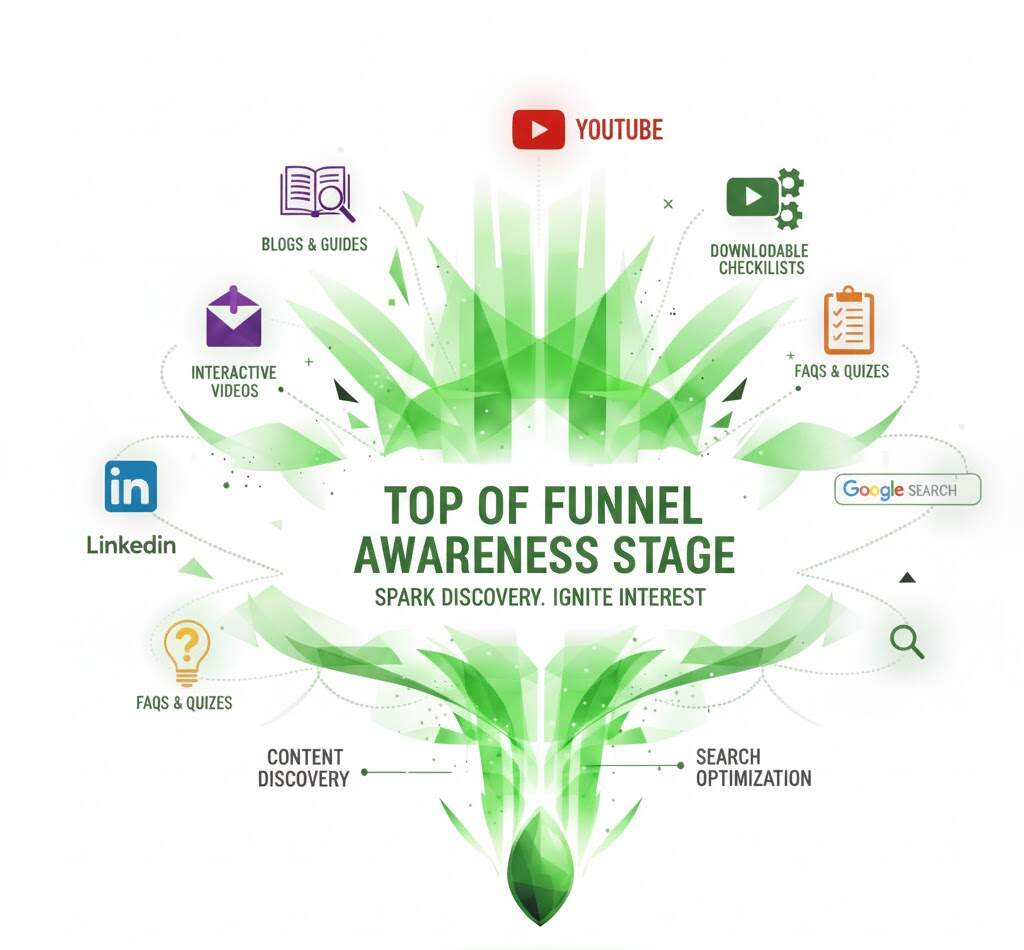
MOFU – Middle of the Funnel (Consideration Stage)
The MOFU stage is where casual attention transforms into genuine interest and where many funnels quietly lose momentum. Here, your job isn’t to sell; it’s to nurture trust through depth, relevance, and consistency. Research from HubSpot shows that nurtured leads make 47% larger purchases than those who aren’t nurtured, and effective programs produce more sales-ready leads at a lower cost.
Build a content rhythm that feels valuable, not invasive; think welcome email series, weekly insights, and one high-value offer each month (like a calculator, template, or interactive webinar). Create mid-funnel assets such as mini-webinars, ROI-focused blogs, case studies, and gated checklists that solve real problems. Add marketing automation with tools like HubSpot, ActiveCampaign, or Mailchimp to segment leads based on behavior and engagement. For persuasive mid-funnel copy, revisit SEO copywriting best practices for engagement.

BOFU – Bottom of the Funnel (Decision Stage)
The BOFU stage is the final moment of truth; when prospects are deciding between you, a competitor, or walking away entirely. Here, clarity and confidence win deals. Your goal is to eliminate friction, reduce risk, and guide the decision swiftly. Effective BOFU content tactics includes live demos, free trials, comparison tables, customer success stories, and “what to expect next” onboarding previews. These assets make choices easier and conversions faster.
Keep the buying journey smooth: use concise copy, mobile-first design, and crystal-clear CTAs. Even now, page speed optimization plays a pivotal role — a one-second page load can convert 2.5× higher than a five-second one (Portent). To tighten that last mile, learn how to improve website speed to boost conversions. Add urgency ethically with limited-time offers or transparent bonus incentives like free setup or priority support.
Leverage Funnel Analytics to track assists and micro-conversions, demo requests, proposal views, contract opens. The goal isn’t just closing the deal; it’s delivering confidence that leads to satisfaction and long-term loyalty. In every BOFU stage, refined Marketing Funnel Optimization ensures you convert trust into action efficiently.
 Beyond the Funnel (Retention & Advocacy)
Beyond the Funnel (Retention & Advocacy)
A funnel that stops at “payment received” is a funnel leaking potential. The real growth begins after the sale, when onboarding, delight, and advocacy turn buyers into brand ambassadors. Post-purchase touchpoints, welcome sequences, satisfaction check-ins, loyalty rewards, and community invites; extend your customer’s journey and reignite your TOFU with organic advocacy.
Data proves retention outperforms acquisition: according to Wharton, referred customers deliver 16% higher lifetime value and show stronger loyalty than non-referred ones. Build a simple referral flywheel launch an NPS survey after 30 days, create an “introduce a friend” page, and reward advocacy with small but thoughtful perks like credits, upgrades, or gifts. Keep the engine humming with a high-performance lead generation website that continues nurturing beyond the first sale.
Showcase user-generated content such as testimonials, before-and-after results, and quick-win stories in newsletters or social posts. Treat your support content as growth content, create searchable knowledge bases and “how-to” videos that reduce churn and spark new opportunities. Satisfied customers share, tag, and refer; creating an engine that keeps your funnel alive and thriving.
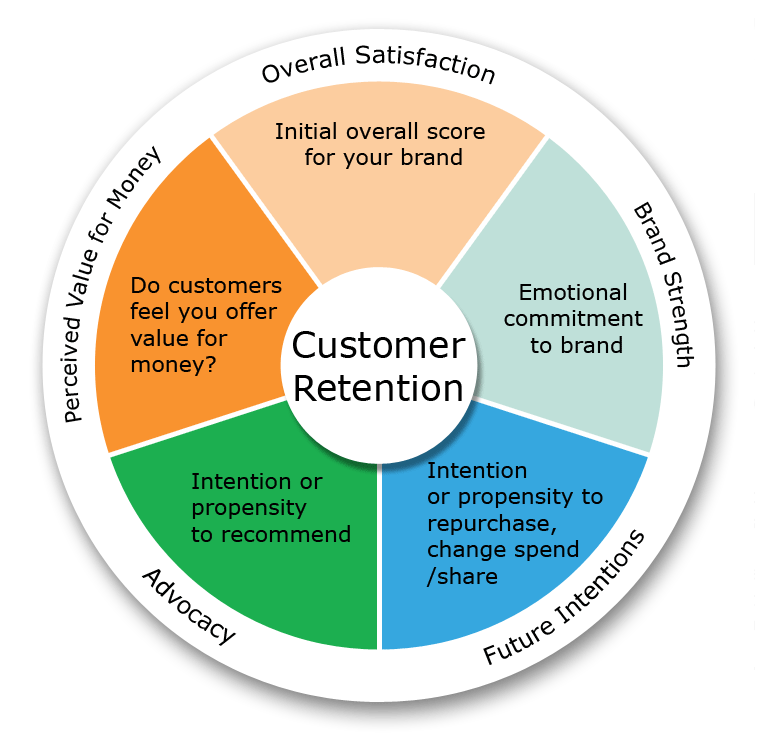
Data, Tools & AI in Funnel Optimization
Modern funnels aren’t static, they’re intelligent, adaptive, and powered by data. AI-driven marketing enables teams to cluster topics, forecast lead quality, and personalize engagement journeys with remarkable precision. When used responsibly, it transforms conversion rate optimization from reactive to predictive. Tools now automate lead scoring by analyzing fit, intent, and behavior, helping marketers focus efforts where conversions are most likely.
AI enhances content velocity, improves operational efficiency, and delivers more personalized customer experiences—critical wins for lean marketing teams. A pragmatic funnel stack includes GA4 for event tracking, Looker Studio for dashboards, HubSpot or Salesforce for CRM and scoring, Mixpanel for product analytics, Hotjar for user behavior mapping, and Segment or RudderStack for unified data routing.
The key is balance. Keep humans in control of tone, claims, and context. Use AI for clustering, summarizing, and first drafts—but rely on expertise for storytelling, empathy, and credibility. Data guides decisions; humans build trust.
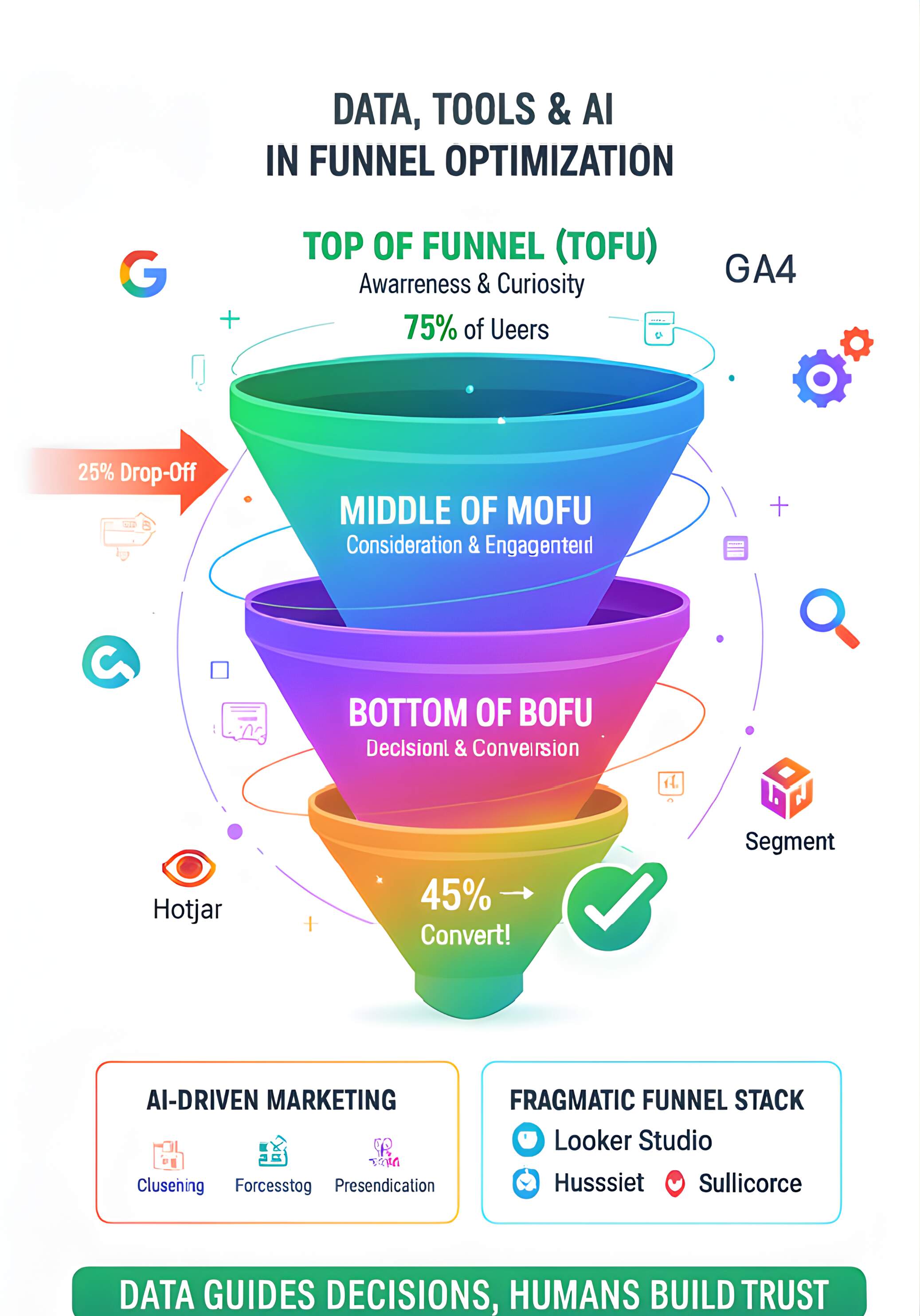
Funnel KPIs & Performance Tracking
A healthy funnel isn’t defined by traffic alone — it’s measured by movement. Every stage should show momentum, clarity, and consistent improvement. For TOFU (Top of Funnel), track metrics like reach, traffic, engaged sessions, click-through rate (CTR), and email capture rate. For MOFU (Middle of Funnel), focus on MQL creation, content downloads, webinar attendance, and meeting-booked rate. At BOFU (Bottom of Funnel), monitor demo-to-close rate, time-to-close, CAC, and LTV to confirm ROI.
Modern buyers are self-educating — nearly 47% view 3–5 pieces of content before ever contacting sales. That’s why you must measure content assists, not just last-click conversions. Conduct monthly or quarterly funnel audits to identify drop-offs, check site performance (Core Web Vitals), and align messaging to new buyer objections. A practical checklist: technical SEO checklist for performance tracking.
Speed remains a critical KPI, as Cloudflare research shows that faster load times consistently improve conversions and reduce bounce rates. The secret to mastery is simple: track everything, set thresholds, and optimize weekly.
![]()
Optimization Checklist
- Track metrics weekly for momentum and clarity.
- Audit funnel stages monthly for drop-offs and lag.
- Use Funnel Analytics to align messaging with buyer behavior.
- Set speed and conversion thresholds for continuous growth.
Action Plan: A 30-Day Playbook for Small Teams
Week 1 (Map & Measure): Define ICPs, top 10 questions, and your current Lead Conversion Funnel. Set up GA4 events, UTMs, and a Looker Studio dashboard.
Week 2 (TOFU Build): Publish two search-led how-tos, one short video, and a downloadable checklist. Boost the best performer with $50 in paid.
Week 3 (MOFU Depth): Launch one gated resource (template/calculator) and a 3-email nurture. Add two proof assets (mini case study + testimonial reel).
Week 4 (BOFU Close): Ship a comparison page, tidy pricing, add a 14-day trial/demo, and implement a time-boxed bonus. Review speed fixes.
Ongoing: Ask for a review/referral at day-30, update the nurture with common questions, and re-cut long videos into shorts.
Tweet Idea (to embed) If you can’t point to a clear asset for each objection, you don’t have a funnel—just content. Map objections → assets → CTAs. #FunnelAnalytics
Summary: Turn Your Funnel into a Growth Engine
Your funnel isn’t a flowchart—it’s your business heartbeat. TOFU attracts, MOFU educates, and BOFU converts, but real magic happens when speed, relevance, and proof unite. Every touchpoint should feel intentional and effortless, guiding prospects from curiosity to confidence. Use marketing automation to personalize timing, content, and tone—then rely on analytics to fine-tune every move. Track performance relentlessly to spot and seal leaks early.
Build retention loops through thoughtful onboarding, customer success stories, and referral programs—they don’t just add revenue; they compound lifetime value while fueling your top-of-funnel organically. (Wharton Faculty Platform) A smart funnel never stops evolving—it listens, adapts, and sells with precision. When performance and empathy meet, your funnel becomes more than a process—it becomes your competitive advantage.
Ready to outsmart your funnel, not just build it?
Mastering TOFU, MOFU, and BOFU is not just a marketing exercise—it’s the foundation of a customer-centric growth engine. With the right blend of marketing funnel optimization, automation, and funnel analytics, your business can turn cold traffic into loyal customers through consistent engagement and precision targeting.
At eSign Web Services, we specialize in designing data-driven funnel marketing strategies that simplify complex journeys and maximize conversions. Whether you need a complete funnel setup, marketing automation, or campaign optimization, our experts can help you achieve scalable growth. Contact us today to transform your funnel into a high-performing lead conversion system.
Frequently Asked Questions (FAQs)
Q1: How long should someone stay in each stage of the funnel?
It depends on your industry, offer complexity, and buyer intent. Typically, TOFU lasts days to weeks, MOFU can stretch weeks to months, and BOFU depends on urgency. Use behavior data—like engagement, downloads, or demo requests—to move leads naturally, not forcefully, through each stage of the funnel.
Q2: What’s the difference between a marketing funnel and a sales funnel?
A marketing funnel attracts and nurtures interest through educational content and brand engagement, while a sales funnel focuses on direct conversion and closing deals. The marketing funnel generates qualified leads, and the sales funnel transforms those leads into paying customers—both work hand-in-hand for sustainable growth.
Q3: How do I know if my funnel is working?
Measure progress across key funnel KPIs: engagement, lead generation, conversion rate, and retention. A healthy funnel shows steady movement—visitors becoming leads, leads turning into customers. Regularly analyze drop-off points using analytics and heatmaps, then refine content or CTAs to keep conversion momentum strong.
Q4: Can small businesses compete with big companies using funnels?
Absolutely. Funnels level the playing field. Small businesses can use personalization, authentic storytelling, and speed to outshine large brands. A well-structured funnel powered by conversion rate optimization and website speed optimization delivers higher engagement without massive budgets. Agility, empathy, and precision beat scale every time.
Q5: What tools do I need to build a marketing funnel?
Start with HubSpot or ActiveCampaign for automation, Google Analytics 4 for data, Looker Studio for dashboards, and Hotjar for behavior tracking. Add tools like Canva for visuals and Ahrefs for SEO insights. Choose integrated, scalable tools that simplify funnel monitoring, tracking, and optimization across stages.
Q6: How often should I update my funnel content?
Audit content every quarter. Update statistics, visuals, and CTAs based on performance metrics and audience behavior. Outdated or irrelevant content reduces trust and engagement. Keeping content current ensures your funnel remains aligned with audience needs, improving both lead quality and conversion efficiency over time.
Q7: What’s the biggest mistake people make with TOFU content?
Focusing too much on selling instead of helping. TOFU should educate, entertain, and build trust—not push products. When content answers questions and solves early-stage pain points, it naturally earns engagement. “Teach, don’t tout” remains the golden rule for attracting qualified top-funnel leads effectively.
Q8: How many touchpoints does it take to convert a lead?
Studies suggest it takes 7–13 touchpoints before conversion, depending on complexity and intent. These include blog posts, emails, social ads, or demos. Each interaction builds familiarity and confidence. The key isn’t quantity—it’s consistency and relevance across your marketing funnel stages that drive decisions.
Q9: How do AI and automation improve funnel performance?
AI helps segment leads, personalize emails, predict intent, and identify conversion bottlenecks. Tools like HubSpot AI or Salesforce Einstein automate repetitive tasks and optimize timing. This ensures the right content reaches the right audience faster, increasing efficiency, engagement, and measurable ROI across your funnel.


